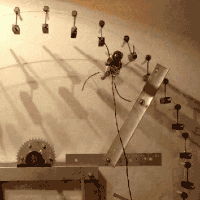Mikhail Dmitriev Gravity Wheel
From PESWiki
by
Sterling D. Allan
Pure Energy Systems News
January 30, 2011
Russian inventor, Mikhail Dmitriev contacted me on January 28 to let
me know about his gravity motor. He has apparently devised a
mechanism whereby static gravitational pull can be harnessed to
generate useful energy.
He has been working on various iterations over the years. A more recent one is shown to the right. In it, a small motor shown at about the 2-o-clock location spins a deflector mechanism clockwise. The deflectors push dangling weights to the right. Being on a counter-clockwise ratchet, this causes those evenly-spaced weights to stay outward long enough to cause the larger wheel to be imbalanced and thus turn clockwise.
The claim is that the energy required to turn the small motor is much less than the energy gained from the imbalanced larger wheel turning a generator. It reminds me of the system devised by British inventor, Bobby Amarasingam, the AOGFG, which he is in process of taking commercial. From what I can gather, AOGFG is further along in engineering market-ready iterations which can produce substantial power.
As I look at the photos and the animation of Mikhail's setup, it seems to me like it would be very easy to build. I could do it. A junior high student could do it from a kit.
He said that "Many enthusiasts in Russia have already made the device for home use." I asked him to give me an example of the input/output power, to which he replied:
- A typical instance in the range 0.5 - 5 kW. The average size (1500 * 1500 * 700) mm. The average weight of 200 kg. Rotational speed (60 - 120) rpm. Design-folding. Costs here in the $(500 - 2000). This handmade mechanical part, without the electrical generator (output). Industrial production (assembly line) should be much cheaper. The most expensive items - overrunning clutches, Niodim strong magnets and output electrical generator (alternator).
- Now, under my leadership, a firm builds an instance of an output power of 50 kW. This will be a multistage amplifier (4 stages). At the entrance of only 100 watts needed. An electric generator is only at the last output stage.
The PCT patent application describes this mechanism as a torque amplifier, but doesn't mention that more energy comes out than what is put in.
Mikhail said that he is NOT planning to take his device commercial because of the corruption in his country which would steal the technology away from him. Meanwhile, he says he has been helping many people to implement the technology into power generators they can use at home – sometimes powering those homes entirely.
I've approached him about helping him open source the technology, to expedite the process of validating, replicating, characterizing, optimizing, and improving the design for rapid worldwide deployment; with some revenue opportunities along the way in selling plans, kits, components, and finished units. I would ask up front here that anyone who goes commercial with this design remit a 7% royalty, a majority of which we at PES Network, Inc. will remit to Mikhail, retaining some to help administer this project and promulgate the knowledge, including providing income to the key players in the project, such as those who prepare the plans, do the translations, find local parts, etc….
On January 20, 2011 6:26 AM MST, Mikhail wrote:
- Hi Sterling,
- Yes, I'm willing to work with you to open source the technology.
- This will be discussed in future correspondence.
- I think that first you need to personally make sure that the device works as claimed. To do this, make a demo version directly at your workshop. This will be the most persuasive and credible evidence.
- If you agree, then I'll send you a very simple scheme which you can make in just a couple of days. Compact desktop version (components only) will cost about $100.
Of course I told him yes.
PESN.com
Copyright © 2002-2010,
PES Network Inc.
